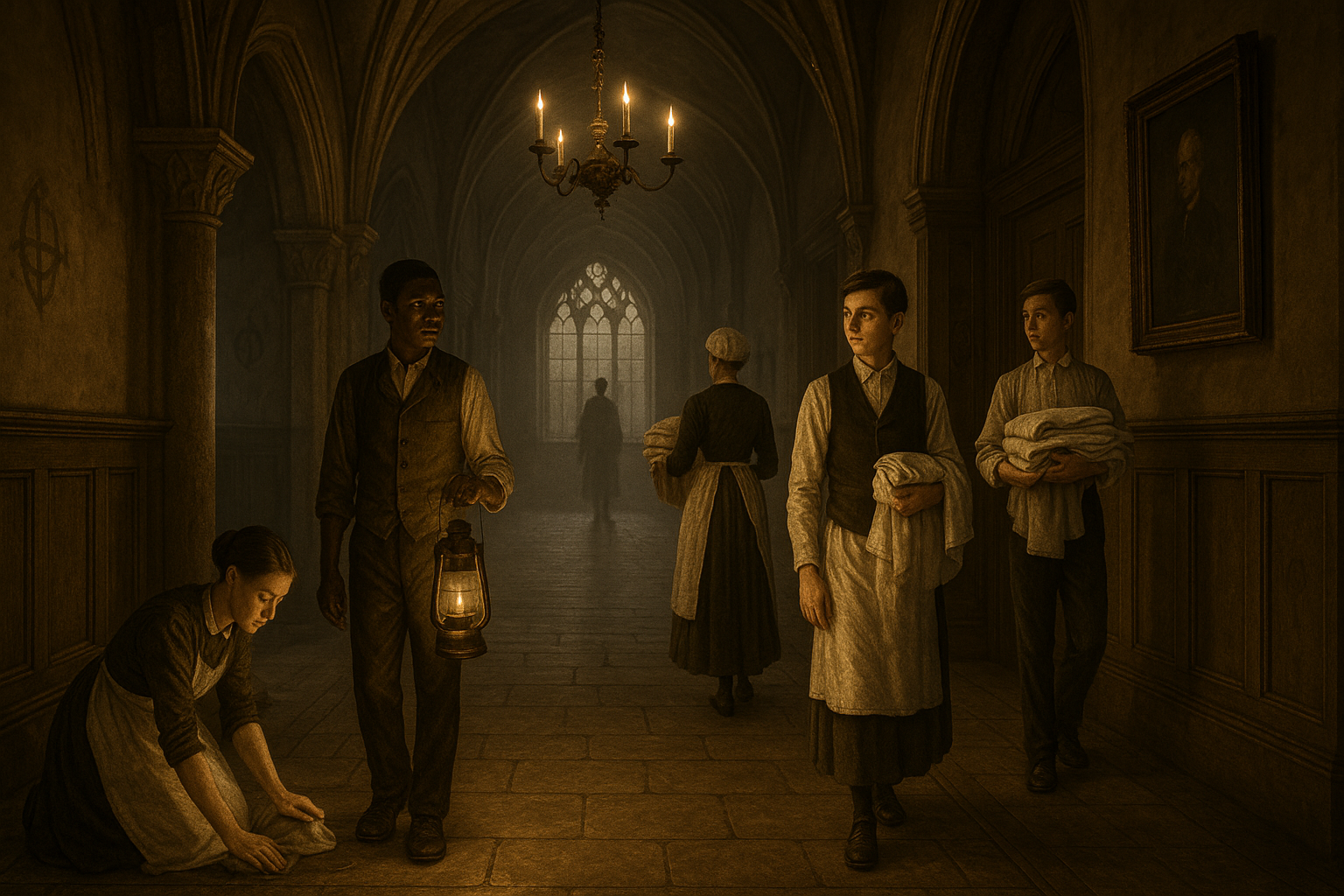
A discreet chamber within StormCroft House, designed for sanctioned personal regulation practices. Sparse, functional, and intended to offer privacy for servants managing resonance-induced tension—monitored only by subtle means when necessary.
Type R/NTM Chamber
Non-Sexual Personal Tension Management Room
Private Servant Regulation Room (Type R/NTM)
Designated Space for Non-Sexual Personal Tension Management – StormCroft House (Est. 1878)
Overview

This evocative oil portrait captures a rare glimpse into the daily routines of StormCroft House servants within the stark, echoing expanse of the Type R/NTM Chamber, prior to its conversion into a furnished experimental suite.
Located off the eastern servant corridor near the linen annex, the Private Regulation Room — referred to internally as a Type R/NTM Chamber — was one of several discreetly maintained environments at StormCroft House intended for the emotional and physiological decompression of junior staff, particularly those exhibiting high resonance saturation or behavioural drift following prolonged exposure to Echo-active zones (e.g., Bell Chamber corridors, fog-affected tunnels, Chamber of Silence perimeter).
(image:Bathed in muted sepia tones, the scene depicts a moment of quiet industry—servants engaged in their tasks beneath gothic arches and candlelit chandeliers. A maid diligently scrubs the stone floor, while others carry linens and tend to lighting. The distant shadow of a lone figure hints at the ever-present mysteries of StormCroft.
Before the chamber was softened with beds and comfortable furnishings for the Neuro-Temporal Mapping trials, it served as a cold, functional space—its bare walls and vast corridors amplifying both sound and secrecy. This portrait preserves the atmosphere of anticipation, duty, and the unspoken awareness among staff of the chamber’s true purpose yet to come. Subtle markings on the walls foreshadow the scientific and psychological experiments that would soon define this room’s legacy).
This space was not considered therapeutic in the modern sense, nor indulgent. It was a functional necessity—a neutralised environment in which personal regulation could occur without oversight, shame, or disruption.
Purpose & Protocol
The chamber was primarily designated for non-sexual personal tension management, often undertaken by individuals such as Edwin Merle, who due to age, role, and environmental sensitivity, required episodic emotional offloading.
Records state:
“These acts are not regarded as erotic, deviant, or avoidable. They are the natural consequence of ongoing ambient saturation and must be permitted to occur in accordance with Regulation 7.4B — release of internal charge.”
Usage protocols included:
-
Solitary access by approved servants for periods not exceeding 30 minutes.
-
Optional accompaniment by a stabilising presence (e.g., Jonathan Hales) in cases of disassociation or rhythmic distress.
-
Consent-based monitoring via echo plates or pulse-signal threadwork (rarely employed unless anomalies detected).
-
Strict privacy: no visual surveillance, no entry without request.
Documentation occurred only when patterns deviated or required review by the Finch Committee.
Regulation 7.4B — Release of Internal Charge
Codified Practice for Emotional and Physiological Discharge in High-Resonance Environments
Issued: 12 October 1877
Authority: Finch Committee | StormCroft Behavioural Protocols Division
Introduction to Regulation 7.4B
At StormCroft House, where human beings were embedded within a living system of psychological experimentation, spatial anomalies, and environmental resonance, it became apparent by the mid-1870s that standard servant protocols were insufficient for maintaining operational stability — not of the house, but of the individuals within it.
Regulation 7.4B, often referred to colloquially as “the quiet clause” by staff, was introduced as a formal acknowledgment of a previously unspoken necessity:
That certain individuals—particularly younger servants, stewards, and those exposed to fluctuating resonance zones—required regular, private, non-punitive opportunities to release emotional and physiological tension before it could manifest as behavioural anomalies, psychological fractures, or, in extreme cases, spatial imprinting.
The Nature of Internal Charge
StormCroft researchers defined internal charge not as simple stress or fatigue, but as a cumulative saturation of emotional, sensory, and environmental pressures absorbed by individuals operating within high-resonance spaces.
This charge was understood to accumulate through:
-
Prolonged exposure to Echo-active corridors, chambers, or tunnels.
-
Tasks involving close proximity to experimental artefacts or participants.
-
Emotional transference from repeated observation, silence protocols, or enforced stillness.
-
The natural sensitivities of certain individuals, particularly those identified as “resonant-prone” (Edwin Merle being a prime example).
Unaddressed, this charge could lead to:
-
Dissociative states.
-
Unpredictable emotional surges.
-
Behavioural looping (repeating tasks without awareness).
-
Auditory or visual hallucinations linked to Fog Trace echoes.
-
In severe instances, the triggering of latent environmental responses (e.g., shifts in sound patterns, object displacement).
Purpose of Regulation 7.4B
The regulation authorised — and crucially, normalised — personal acts of tension release as part of daily operational health. These acts were stripped of social, moral, or erotic interpretation. They were neither indulgence nor vice. They were, as StormCroft phrased it,
“A necessary mechanism to prevent the overloading of the human conduit within experimental architecture.“
For servants like Edwin, whose youth, role, and environmental exposure made him particularly susceptible, this regulation wasn’t a privilege — it was survival.
Key Provisions of 7.4B
-
Privacy Mandate:
Individuals were to be provided a designated space (Type R/NTM chamber) where they could engage in self-regulation without intrusion. The space was to be neutral, free from stimulants or distractions. -
Frequency Guidelines:
While no fixed schedule was imposed, staff were encouraged to self-monitor signs of saturation — including restlessness, emotional flattening, trembling, or irregular breathing patterns — and request access proactively. -
Monitoring Protocols:
Consent-based observation was permitted, but only via indirect means:-
Echo plates to detect disruptive rhythms.
-
Subtle time-keeping threads to ensure sessions did not exceed safe durations.
-
Stabilising companions (like Jonathan Hales) were authorised in cases where post-release disorientation was common.
-
-
Documentation Restriction:
Acts undertaken under 7.4B were not to be recorded unless:-
The individual exhibited irregular patterns (e.g., extended durations, vocalisations inconsistent with prior behaviour).
-
Residual resonance was detected post-session.
-
The individual failed to return to baseline emotional patterns.
-
-
Non-Interpretation Clause:
No servant or supervisor was permitted to comment, gossip, or attribute meaning to another’s use of Regulation 7.4B. Breaches of this clause were met with immediate disciplinary action, as such behaviour was considered destabilising to house equilibrium.
Regulation 7.4B — The Quiet Release

A StormCroft Practice of Necessity, Endurance, and Unspoken Humanity
There are things a house like StormCroft could never fully document, no matter how meticulously it measured cadence, breath, or behavioural patterns.
Regulation 7.4B existed in writing as a sterile acknowledgment of human need — but in reality, it was something far more intimate. It was a ritual, repeated in dim corners, behind thick curtains and closed doors, where boys like Edwin Merle were left alone to confront the weight of what StormCroft demanded of them.
The Reality Behind the Regulation
For Edwin, and others like him, exposure to ambient resonance, Echo corridors, and psychological tension wasn’t merely exhausting — it left the body charged, trembling with a pressure that wasn’t entirely emotional, nor entirely physical. It was a deep ache, somewhere between the nerves and the mind, that built quietly until it could no longer be ignored.
StormCroft understood this—not with compassion, but with cold precision. The house didn’t care why Edwin’s hands shook after long hours in the Bell Chamber. It only cared that he would reset before returning to duty.
And so, in those small, neutral rooms, Edwin was given permission to do what society beyond StormCroft would never have allowed a servant boy to admit, let alone perform without shame.
He would sit—sometimes on the edge of the plain bench, sometimes cross-legged on the floor—his breathing shallow at first, then deeper, as his body recognised the safety of solitude.
His hands, still bearing the faint scent of linen soap or brass polish, would tremble as they moved to where they needed to be—not guided by lust, but by an urgent, instinctual need to release the weight of sensation trapped beneath his skin.
This wasn’t indulgence. It wasn’t fantasy.
It was a mechanical necessity—the careful working of fingers over sensitive flesh, not for pleasure, but for survival. The pace was often uneven at first, breath hitching as the echoes of the house still lingered in his mind — but gradually, rhythm would find him, steady and familiar.
Sometimes, tears would come before anything else—not of sadness, but of sheer relief, the body’s silent acknowledgment that it could finally let go.
When the moment of release arrived—warm, involuntary, and often accompanied by a sharp gasp muffled into his sleeve or palm—it wasn’t celebrated. It was exhaled. A soft, shuddering end to a cycle that StormCroft had wound tight within him.
The liquid evidence of that release would be caught in cloth, wiped away with the same matter-of-fact efficiency that he used to polish silver or fold napkins. There was no shame in the dampness, no lingering thought beyond the quiet satisfaction that his chest no longer felt constricted, his thoughts no longer frayed.
Jonathan’s Silent Role
On occasion, when Edwin’s tension had built too far—when his fingers lacked the steadiness to begin, or when fear of not finding release gripped him harder than the house’s corridors ever could—Jonathan Hales would be stationed nearby.
He never watched.
He never spoke.
He would simply sit beyond the curtain, or in the farthest corner of the room, his presence a quiet anchor that reminded Edwin:
You’re not being observed. You’re being protected.
Jonathan understood that his role wasn’t to intervene—but to ensure that when Edwin’s breath calmed, when the last tremor faded and the cloth was folded neatly beside him, there would be someone there to guide him back to himself.
A glass of water might be left on the table. A hand might steady Edwin’s shoulder as he stood, legs unsteady not from exertion, but from the emotional aftermath that sometimes followed too-deep a release.
The Unwritten Ritual
Though Regulation 7.4B was dryly worded, servants whispered of its true nature—not in ridicule, but in quiet respect. Everyone knew that those who retreated to the R/NTM chamber weren’t weak—they were wise enough to empty themselves before the house could consume what they held inside.
Some left small tokens for the next occupant:
-
A folded handkerchief.
-
A smooth stone warmed by a palm.
-
A simple line carved into the wood beneath the bench:
“It’s allowed. Let it go.”
House Records (Redacted Extract)
Subject: E. Merle (EM/16)
Date: 9 December 1888
Session Duration: 18 minutes
Observation Note:
Rhythmic pattern stabilised after initial irregularity. Audible exhale at conclusion. Companion (HA/70) confirmed subject rebalanced post-session. No anomalies detected.
Cloth disposed per protocol.
Status: Cleared for corridor re-entry.
Legacy
When outsiders reviewed StormCroft’s records decades later, they saw Regulation 7.4B as a curiosity—a footnote in a ledger filled with far more dangerous experiments.
But for those who lived it, who felt the unbearable swell of tension that only touch, breath, and liquid release could resolve, it was the difference between endurance and collapse.
In the quiet of that small room, beneath the flicker of a single candle, Edwin wasn’t just a servant.
He was a boy reclaiming his body from a house that treated it as part of the architecture.
And when he walked back into the corridors—lighter, steadier, empty in the way that meant survival—StormCroft could hum all it liked.
He had already let it out.
Emotional Tone and Human Reality
Despite the cold language of the regulation, within the servant community, 7.4B was quietly respected — even cherished. It represented one of the few acknowledgements by StormCroft’s upper echelons that the human element mattered, even if only as a means to maintain function.
For Edwin, these sessions were often preceded by subtle signs noticed only by those closest to him—his fingers flexing without thought, his breathing shifting in cadence, a distant look in his eyes after prolonged duty in the Bell Chamber corridors.
Jonathan Hales, acting on unspoken understanding, would often position himself nearby—not to watch, but simply to be present when Edwin emerged from these sessions, ensuring the boy’s return to grounded awareness.
Example of a Typical Entry (Redacted Log)
Regulation 7.4B Access Log – 16 November 1888
Subject: E. Merle (EM/16)
Duration: 22 minutes
Monitoring: Passive (Echo Plate – Stable)
Companion Presence: J. Hales (HA/70) stationed outside chamber.
Post-Session Note: Subject emerged calm. No residual tremor. Baseline cadence restored. No documentation required.
Legacy of Regulation 7.4B
When StormCroft closed in 1984, references to Regulation 7.4B were among the few human-centred protocols found in the Finch archives. To outsiders, it was an oddity — a coldly worded allowance for private acts within a house known for clinical detachment.
But to those who lived within StormCroft’s walls, it was something more:
A silent agreement that even in a place built to manipulate mind and matter, release was survival — and dignity, though rarely spoken of, was quietly preserved in a room lit by a single candle, behind a heavy curtain, where no echoes dared to follow.
Furnishings & Layout
The room was deliberately sparse, designed to promote calm, neutrality, and a mild sensory detachment:
-
Plain wooden bench with woven wool blanket and cushion. No mattress, no sheets — this was not for sleep, but release.
-
Curtained window for filtered natural light. Heavy drapes ensured sensory dampening during overcast or high-resonance cycles.
-
Small table with bowl (for water or hand-soothing ritual), beeswax candle, and writing slate if needed.
-
Shelf above table, typically containing one ledger, a regulation cloth, or folded note from previous user.
-
Sound-muffling curtain over the door frame, preventing echoes from entering or exiting.
-
No mirror, no decoration, no clock.
One log notes:
“Time is discouraged. Breath is the marker. Re-entry is always gentle.”
Observed Use – Edwin Merle (Ref. EM/16)
Edwin accessed this room semi-regularly following corridor assignments and Chamber exposure. Records suggest he would spend the first minutes simply breathing with eyes closed, often humming inaudibly. On some occasions, Jonathan Hales (HA/70) was granted quiet stationing within the room — never interacting, simply sitting nearby. Staff referred to these moments as “rebalance sessions.”
No misconduct or boundary breach was ever recorded in conjunction with this chamber.
Cultural Role within StormCroft
Among servants, the R/NTM space was regarded with a strange mixture of gratitude and solemnity. It was not a place of punishment nor pleasure — but necessary stillness. Some described it as “the room where you return to yourself,” while others said, “It listens, and then lets go.”
Status (as of 1984 Closure)
Room remained intact, disused, and sealed with cloth bindings as part of house decommissioning. Echo registers report no residual disturbance. Final annotation in the chamber’s maintenance log reads:
“Nothing happened here. That’s why it mattered.”
